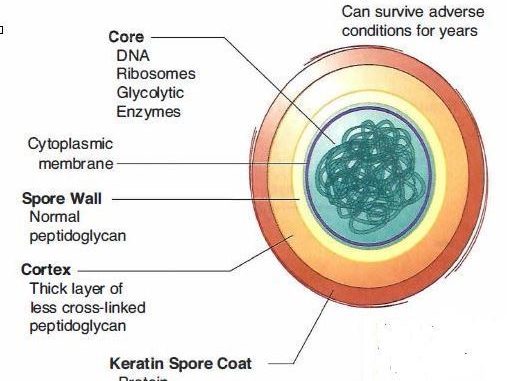
- Certain species of bacteria produce spores, which are metabolically dormant structure and might be present either within the cell (endospores) or external to the cell (exospores).
- Under appropriate conditions, these dormant structures called spores can undergo germination and outgrowth to form a vegetative cell.
- Endospores:
- These structures are unique to bacteria. They are thick-walled, highly refractile bodies that are produced (one per cell) by Bacillus, Clostridium, Sporosarcina, Thermoactinomyces, and a few other genera.
- The shapes of endospores and also their location within the vegetative cell vary depending on the species.
- Endospores are usually produced by cells growing in rich media but which are approaching the end of active growth. Various factors such as ageing or heat treatment are needed to activate the dormant spores (i.e. permit them to be able to undergo germination and outgrowth when they are placed in a suitable medium).
- Endospores are extremely resistant to desiccation, staining, disinfecting chemicals, radiation, and heat. For example, the endospores of Clostridium botulinum type A have been reported to resist boiling for several hours.
- The degree of heat resistance varies with the bacterial species, but most can resist treatment at 800C for at least 10 minutes.
- During sporulation, a dehydration process occurs in which most of the water in the developing spores is expelled; the resulting dehydrated state may be an important factor for heat resistance.
- All endospores contain large amounts of dipicolinic acid (DPA), a unique compound that is undetectable in the vegetative cells yet can account for 10 to 15 % of the spore’s dry weight.
- It occurs in combination with large amounts of calcium and is probably located in the core, i.e. in the central part of the endospores.
- The calcium-DPA complex may possibly play a role in the heat resistance of endospores. Synthesis of DPA and the uptake of calcium occur during advanced stages of sporulation.
- During germination, endospores lose their resistance to heat and staining. Subsequent outgrowth occurs, characterized by synthesis of new cell material and development of the organism into a growing cell.
- Exospores:
- Cells of methane- oxidizing genus Methylosinus form exospores, i.e. spores external to the vegetative cell, by budding at one end of the cell.
- These are resistant to heat and desiccation, but do not contain DPA.
- Conidiospores and sporangiospores:
- The large group of bacteria known as the actinomycetes form branching hyphae; spore develops, singly or in chains, from the tips of these hyphae by cross wall formation (septation).
- If the spores are contained in an enclosing sac (sporangium), they are termed sporangiospores; if not they are called conidiospores (or conidia)
- These spores do not have the high heat resistance of endospores, but they can survive long periods of drying.